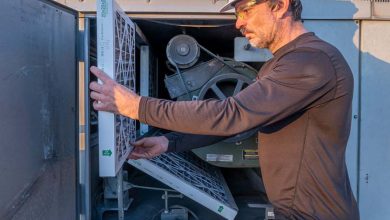
Understanding The Basics of Cutting And Bending Job Work in Coimbatore
Cutting and bending Job work in Coimbatore is essential in many manufacturing industries, particularly metal fabrication. Cutting raw materials such as steel and aluminium into specific shapes and sizes and then bending them into desired forms is part of the process. We’ll go over everything you need to know about cutting and bending jobs in this blog.
Why Cutting and Bending Job Work is Important
Cutting and bending job work in Coimbatore are important in many industries because they help transform raw materials into useful products. Metal frames for buildings, bridges, and other structures, as well as metal components for machines, vehicles, and consumer goods, are all manufactured using this process.
The Process of Cutting and Bending Job Work
Preparation: In this stage, the materials to be cut and bent are collected and prepared for the process. This may involve cleaning the materials, measuring and marking them, and organizing them into manageable sizes and shapes.
Cutting: The next step is to cut the materials to the required length and shape. This may involve using various cutting tools, such as saws, shears, or plasma cutters, depending on the type and thickness of the material being cut.
Bending: Once the materials have been cut, they are then bent into the desired shape using a variety of bending tools, such as presses, brake presses, or roll benders. The process of bending may involve heating the material, depending on the type of metal being bent and the desired shape.
Assembly: After the materials have been cut and bent, they are then assembled into the final product. This may involve welding, riveting, or bolting the pieces together, depending on the type of product being manufactured.
Quality control: The final step is to inspect the finished product to ensure that it meets the required specifications. This may involve measuring the product, testing its strength and durability, and checking for any defects or irregularities
Overall, cutting and bending job work necessitates a blend of manual skills, technical knowledge, and specialised tools and equipment. It is an important part of many manufacturing processes and is used to make a variety of products such as structural steel components, metal products, and sheet metal parts.
Types of Cutting Methods
There are several types of cutting methods that are commonly used in metal fabrication. These include:
Saw Cutting: A saw blade is used to make cuts in this conventional method of cutting metal. It is a low-cost option, but the cuts produced are not as precise as those produced by other methods.
Plasma Cutting: This method melts and cuts metal using high-temperature plasma. It is a fast and accurate cutting method that is ideal for cutting thick metal plates.
Laser Cutting: A laser beam is used in this method to make precise cuts in metal. Laser cutting is excellent for creating complex shapes and intricate designs, and it is frequently used in high-precision applications.
Waterjet Cutting: Metal is cut using high-pressure water in this method. It is a clean and environmentally friendly cutting method that is ideal for cutting delicate materials that would be damaged by other methods.
Oxy-Fuel Cutting: To cut metal, this method combines oxygen and fuel gas. It is a versatile cutting method that is ideal for cutting thick metal plates.
CNC Cutting: Metal is cut using computer numerical control (CNC) technology in this method. It’s a quick and accurate way to cut complex shapes and intricate designs.
Each of these cutting methods has its own strengths and weaknesses, and the best method for a particular job will depend on the type of metal being cut, the thickness of the metal, and the desired end product.
Types of Bending Methods
There are several types of bending methods that are commonly used in metal fabrication, including:
Press Brake Bending: A press brake machine is used in this method to bend metal into the desired shape. It’s a precise and accurate bending method that’s ideal for producing consistent bends with tight tolerances.
Roll Bending: Rollers are used in this method to bend the metal around a curved axis. The material is fed between two rollers, which apply pressure and bend the metal. Roll bending is commonly used for large-radius bends found in pipes or structural beams.
Induction Bending: This method entails heating the metal before bending it into the desired shape. It is a quick and accurate bending method that is ideal for producing consistent bends with tight tolerances.
Hydraulic Bending: This method bends metal into a specific shape by using hydraulic pressure. It is a fast and powerful bending method that is ideal for producing large, complex bends.
Spiral Bending: A spiral tool is used in this method to bend metal into a specific shape. It is a precise and accurate bending method that is ideal for producing consistent bends with tight tolerances.
Advantages of Cutting and Bending Job Work
Customisation: Job work in cutting and bending allows for the creation of customised metal parts to meet specific requirements and specifications.
Cost-effectiveness: Metal fabrication work is frequently more cost-effective than purchasing pre-made metal parts, particularly for small to medium-sized projects.
Improved quality: Fabrication work frequently produces higher-quality parts because it allows for close monitoring of the manufacturing process and the ability to make adjustments as needed.
Increased efficiency: Metal fabrication job work can help increase the efficiency of a production line by reducing lead times and eliminating the need for inventory storage.
Versatility: Metal fabrication can be used to create a wide range of metal parts, including structural elements, machinery components, and consumer goods.
Increased control: By using Cutting and bending job work in Coimbatore manufacturers can have greater control over the production process, including quality control, and the ability to make design changes as needed.
Environmental sustainability: Metal fabrication job work can also contribute to environmental sustainability by reducing waste and using recyclable materials.
Overall, cutting and bending job work offers many benefits for manufacturers and other users, providing a flexible and cost-effective solution for creating custom metal parts.
Why GK Industries
GK Industries is an ISO 9001:2015 certified company that manufactures and exports a wide range of Cutting and bending job work in Coimbatore is an important process in many manufacturing industries, allowing raw materials to be transformed into useful products. This process involves several steps and techniques to ensure the final product meets the required specifications, from selecting the appropriate raw material to cutting and bending the metal into the desired form. Understanding the cutting and bending job work process can help you make informed decisions and ensure the quality of your final product, whether you’re in the metal fabrication industry or looking to have a metal product manufactured.






